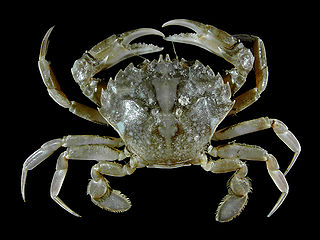
Crabs are decapod crustaceans of the infraorder Brachyura, which typically have a very short projecting "tail" (abdomen), usually hidden entirely under the thorax. They live in all the world's oceans, in fresh water, and on land, are generally covered with a thick exoskeleton, and have a single pair of pincers. Many other animals with similar names – such as hermit crabs, king crabs, porcelain crabs, horseshoe crabs, and crab lice – are not true crabs, but many have evolved features similar to true crabs in a process of carcinisation.

The Decapoda or decapods are an order of crustaceans within the class Malacostraca, including many familiar groups, such as crayfish, crabs, lobsters, prawns, and shrimp. Most decapods are scavengers. The order is estimated to contain nearly 15,000 species in around 2,700 genera, with around 3,300 fossil species. Nearly half of these species are crabs, with the shrimp and Anomura including hermit crabs, porcelain crabs, squat lobsters making up the bulk of the remainder. The earliest fossil decapod is the Devonian Palaeopalaemon.
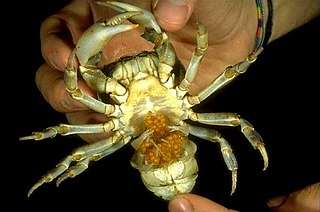
Pleocyemata is a suborder of decapod crustaceans, erected by Martin Burkenroad in 1963. Burkenroad's classification replaced the earlier sub-orders of Natantia and Reptantia with the monophyletic groups Dendrobranchiata (prawns) and Pleocyemata. Pleocyemata contains all the members of the Reptantia, as well as the Stenopodidea, and Caridea, which contains the true shrimp. Pleocyemata comprises the following infraorders:

Squat lobsters are dorsoventrally flattened crustaceans with long tails held curled beneath the cephalothorax. They are found in the two superfamilies Galatheoidea and Chirostyloidea, which form part of the decapod infraorder Anomura, alongside groups including the hermit crabs and mole crabs. They are distributed worldwide in the oceans, and occur from near the surface to deep sea hydrothermal vents, with one species occupying caves above sea level. More than 900 species have been described, in around 60 genera. Some species form dense aggregations, either on the sea floor or in the water column, and a small number are commercially fished.
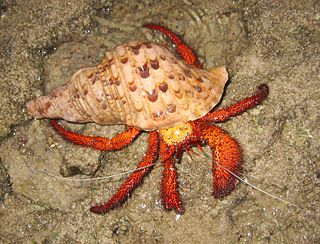
Anomura is a group of decapod crustaceans, including hermit crabs and others. Although the names of many anomurans include the word crab, all true crabs are in the sister group to the Anomura, the Brachyura.

Carcinisation is an example of convergent evolution in which a crustacean evolves into a crab-like form from a non-crab-like form. The term was introduced into evolutionary biology by L. A. Borradaile, who described it as "one of the many attempts of Nature to evolve a crab". Most carcinised crustaceans belong to the order Anomura.
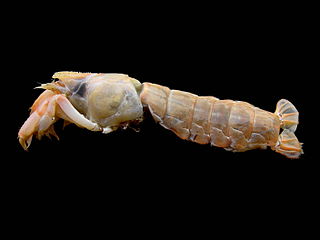
Thalassinidea is a former infraorder of decapod crustaceans that live in burrows in muddy bottoms of the world's oceans. In Australian English, the littoral thalassinidean Trypaea australiensis is referred to as the yabby, frequently used as bait for estuarine fishing; elsewhere, however, they are poorly known, and as such have few vernacular names, "mud lobster" and "ghost shrimp" counting among them. The burrows made by thalassinideans are frequently preserved, and the fossil record of thalassinideans reaches back to the late Jurassic.

Eucarida is a superorder of the Malacostraca, a class of the crustacean subphylum, comprising the decapods, krill, Amphionides and Angustidontida. They are characterised by having the carapace fused to all thoracic segments, and by the possession of stalked eyes.

Kiwa is a genus of marine decapods living at deep-sea hydrothermal vents and cold seeps. The animals are commonly referred to as "yeti lobsters" or "yeti crabs", after the legendary yeti, because of their "hairy" or bristly appearance. The genus is placed in its own family, Kiwaidae, in the superfamily Chirostyloidea.

The hairy stone crab is a crab-like crustacean that lives in the littoral zone of southern Australia from Bunbury, Western Australia, to the Bass Strait. It is the only species in its family. It is 1.5–2.5 cm (0.6–1.0 in) wide, slow-moving, and covered in brown hair which camouflages it against the rocks upon which it lives.

Hippoidea is a superfamily of decapod crustaceans known as sand crabs, mole crabs, sand bugs, or sand fleas.

Dromiacea is a group of crabs, ranked as a section. It contains 240 extant and nearly 300 extinct species. Where they are considered to form a monophyletic group, Dromiacea and two other groups of crabs, namely the Raninoida and Cyclodorippoidea, may be collected together into the Podotremata, each at the rank of subsection; morphological and molecular evidence argue against such a grouping.
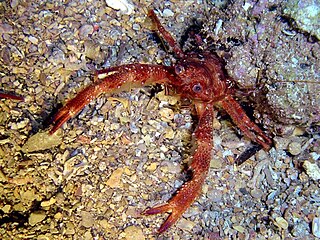
Galathea intermedia is a species of squat lobster found in the north-eastern Atlantic Ocean, as far north as Troms, Norway, south to Dakar and the Mediterranean Sea.

The Pylochelidae are a family of hermit crabs. Its members are commonly called the 'symmetrical hermit crabs'. They live in all the world's oceans, except the Arctic and the Antarctic, at depths of 2,000 m (6,600 ft). Due to their cryptic nature and relative scarcity, only around 60 specimens had been collected before 1987, when a monograph was published detailing a further 400.
Plesionida is a genus of squat lobsters in the family Munididae. As of 2017, it contains the following species:

Shinkaia crosnieri is a species of squat lobster in a monotypic genus in the family Munidopsidae. S. crosnieri lives in deep-sea hydrothermal vent ecosystems, living off of the chemosynthetic activity of certain bacteria living on its setae.

Torbenella is a genus of squat lobsters in the family Munididae, containing the following species:

Chirostyloidea is an anomuran taxon with squat lobster-like representatives. It comprises the three families Chirostylidae, Eumunididae and Kiwaidae. Although representatives of Chirostyloidea are superficially similar to galatheoid squat lobsters, they are more closely related to Lomisoidea and Aegloidea together forming the taxon Australopoda. No fossils can be confidently assigned to the Chirostyloidea, although Pristinaspina may belong either in the family Kiwaidae or Chirostylidae.

Albunea carabus is a rare species of "sand crab" or "mole crab" in the genus Albunea. It lives in shallow, turbulent waters in sandy areas of the tropical eastern Atlantic Ocean and the Mediterranean Sea.

Diogenes heteropsammicola is a species of hermit crab discovered during samplings between 2012 and 2016 in the shallow waters of the Japanese Amami Islands. This D. heteropsammicola is strongly associated with the walking corals. This hermit crab species is unique due to the discovery that they use living, growing coral as a shell. Crustaceans of this type commonly replace their shell as the organism grows in size, but D. heteropsammicola are the first of their kind to use solitary corals as a shell form. Heteropsammia and Heterocyathus are the two solitary corals that this hermit species has been observed as occupying. These two coral species are also used as a home by symbiotic sipunculans of the genus Aspidosiphon, which normally occupy the corals that the crabs were found inhabiting.


















